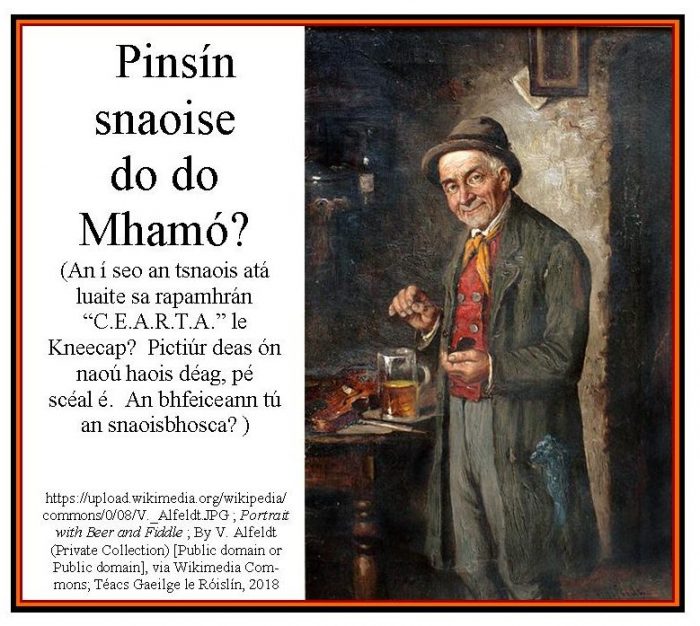A Short Glossary for the Irish Rap Song “C.E.A.R.T.A” by Kneecap (Rapcheol Gaeilge) [Cuid/Pt. 3] Posted by róislín on Jan 15, 2018 in Irish Language
(le Róislín)
Bhuel, anois, seo cuid a trí den ghluais. The “naisc” for the first two installments are listed “thíos,” together with links to the original song text and lyrics. BTW, a few of the entries in this series aren’t really Irish language vocabulary words, but just some references that could perhaps use a bit of additional commentary.véarsa 5: fríd, a Northern variation of “trí/tríd” (through). Not the word “fríd” that means “flesh-worm.”! Is comhainmneacha iad na focail sin.
véarsa 6: ag cóisireacht, partying, based on the word “cóisir” (party, social gathering)
véarsa 6: Séamus Barra, I assume this is a reference to Séamus Barra Ó Súilleabháin, file agus taibhealaíontóir. Féach an nasc d’alt san Irish Times thíos.
véarsa 6: snaois, snuff, as introduced in the first post in this mionsraith covering véarsa 2. As for the exact meaning in the context of this song, hmm, bhuel, do bharúil? “Snaois” [say: sneesh] is an interesting word, since it gives us the intriguing consonant cluster “tsn-” when we add the word “the.” It’s a feminine noun and here are its forms:
snaois, snuff
an tsnaois, the snuff [say: un tneesh, the first “s” becomes silent]
snaoise, of snuff (as in “bosca snaoise,” a snuffbox)
na snaoise, of the snuff (as in “uigeacht na snaoise,” the texture of the snuff)
We can also say “snaoisín” for “snuff,” but the gender becomes masculine with the “-ín” ending, so we say: an snaoisín [no prefixed “t”] for “the snuff,” but, following the typical rules for this category of noun (m4), we say “uigeacht an tsnaoisín (the texture of the snuff), with the “t” getting prefixed for the possessive form (… an tsnaoisín, … of the snuff). The pronunciation follows the same pattern as above, the first “s” dropping out, so for “an tsnaoisín” (of the snuff) say “un TNEESH-een.”
There are at least three ways to say “snuffbox” in Irish: snaoisbhosca, bosca snaoise, and bosca snaoisín. As for the fourth possible option, maybe some people do make a compound noun, with “snaoisín” first and then “bosca” (which would become “bhosca“), but I think the extra syllable (“-ín”) would make this combination less likely.
díolaim … le do Mhaimeo, I sell … to your granny. Note that “le” here means “to,” not the usual “with.” “Maimeo” (with an alternate form “Mamó“) is the familiar word for “granny” or “grandma” in Irish, as opposed to “seanmháthair,” which is the more formal term “grandmother, and which has its own variants (máthair mhór, máthair chríonna). Usually “Maimeo” is a very benign image, but this reference puts a whole new slant on the popular song “Cailleach an Airgid” — remember the refrain: “S í do Mhaimeo í (x3), Cailleach an airgid“. The song title is usually translated as “The Old Hag with the Money.” Anyway, for more on all these “grandmother” terms, please see some of our most popular blogposts on Irish words for grandmother, grandfather, grandma, grandpa, etc. including some with pronunciation tips (naisc thíos).
véarsa 7: D4 is Dublin 4, an upper-middle-class neighborhood known for its distinctive accent, referred to as “DARTspeak” or “DORTspeak.” In the song, the singers say, “D a Ceathair.” In theory they could have said “Baile Átha Cliath a Ceathair” (since “Dublin” is “Baile Átha Cliath) but that would have been a bit long for the meter. The area includes the broadcasting studio of RTÉ, University College Dublin, Aviva Stadium, and some foreign embassies. The area isn’t a complete paradise, as a 2009 independent.ie article (“How Dublin 4 turned into Dublin forlorn”) by Kim Bielenberg suggests but the term still remains a recognizable stereotype, much like saying “Beverly Hills” or “Scarsdale” would connote in the US.
Bhuel, sin cúpla véarsa eile déanta, agus blagmhír nó dhó fágtha sula mbeidh muid críochnaithe leis an amhrán seo. SGF — Róislín
Iarbhlagmhíreanna sa mhionsraith seo faoin amhrán “C.E.A.R.T.A”:
Cuid a hAon den ghluais: A Short Glossary for the Irish Rap Song “C.E.A.R.T.A” by Kneecap (Rapcheol Gaeilge) [Cuid/Pt.1] Posted by róislín on Jan 7, 2018 in Irish Language
Cuid a Dó den ghluais: A Short Glossary for the Irish Rap Song “C.E.A.R.T.A” by Kneecap (Rapcheol Gaeilge) [Cuid/Pt.2]Posted by róislín on Jan 11, 2018 in Irish Language
nasc don amhrán: “C.E.A.R.T.A” le Kneecap, https://www.youtube.com/watch?v=8Sf0htzbMKk
nasc do na liricí: https://nos.ie/cultur/ceol/amhran-na-haoine-cearta-kneecap/ Foireann NÓS 15ú Nollaig 2017 CEOL#amhrán aoine Amhrán na hAoine ‘C.E.A.R.T.A.’, le Kneecap
nasc don alt faoi Shéamus Barra Ó Súilleabháin le Seaghan Mac an tSionnaigh Tue, Jan 17, 2017, 10:00 First published:Tue, Jan 17, 2017, 06:00: https://www.irishtimes.com/culture/books/rapping-as-gaeilge-about-priests-hunger-emigration-and-alcohol-abuse-1.2939137
naisc faoi “grandmother” agus “grandfather” i nGaeilge:
Mór? Críonna? or Sean? — Grandparents By Any Other Name!Posted by róislín on Apr 9, 2009 in Irish Language
Pronunciation tips for Mamó, Móraí, and Daideo (Grandma/Granny and Grandpa)Posted by róislín on Jun 5, 2009 in Irish Language
Dogs and Daideonna (Grandads) in Direct Address “i nGaeilge” – agus Mamónna Freisin (and Grandmoms too)Posted by róislín on Jun 8, 2009 in Irish Language
If the other grandmother is “Grandma,” what Irish term can you use?Posted by róislín on Oct 24, 2016 in Irish Language
If the other grandfather is “Grandpa,” what Irish term can you use?Posted by róislín on Oct 27, 2016 in Irish Language
Saying “Stepgrandmother” and “Stepgrandfather” in IrishPosted by róislín on Oct 29, 2016 in Irish Language

Build vocabulary, practice pronunciation, and more with Transparent Language Online. Available anytime, anywhere, on any device.





Leave a comment: